Poison Prevention for Pets
March 5, 2025
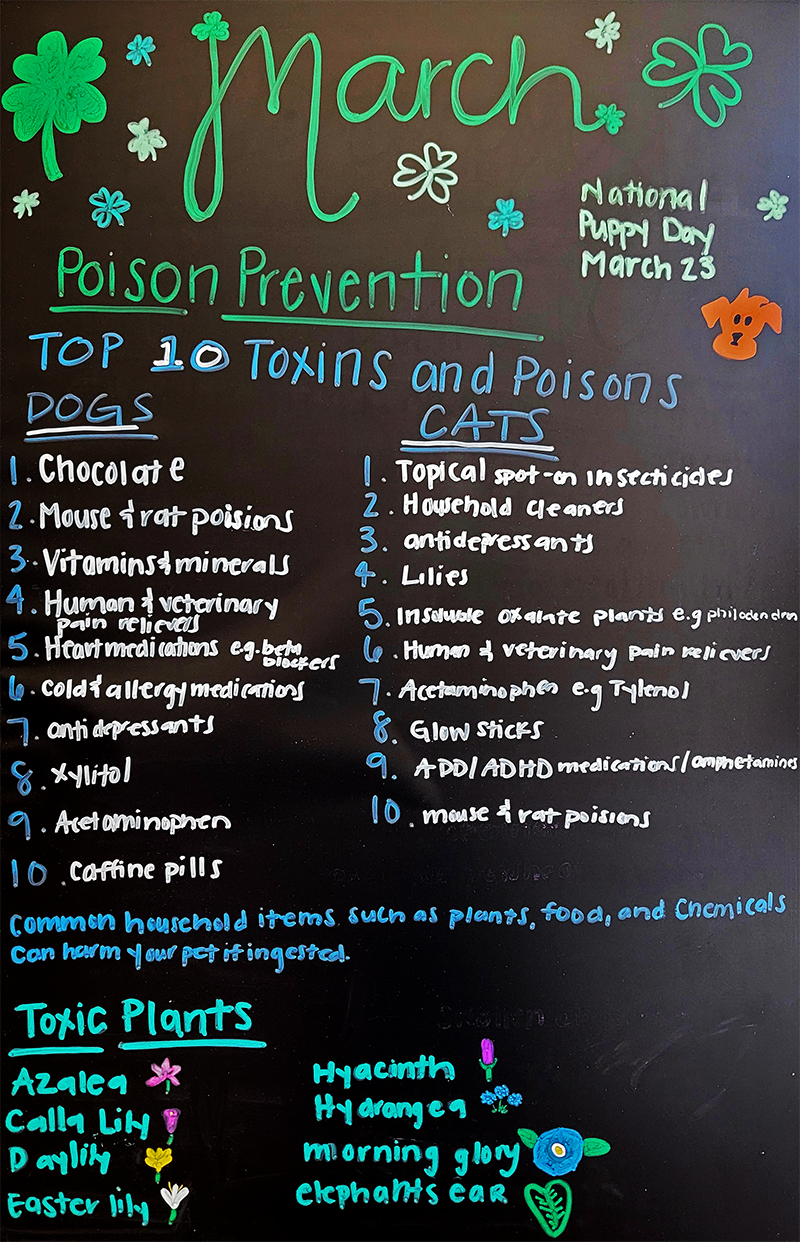
March is Poison Prevention Month
Let’s work together to promote safe and healthy environments for our pets! Many top toxins and poisons overlap for dogs and cats, but there are some differences. Here are the top 10 for each.
Top 10 Toxins and Poisons for Dogs
These are the most common toxins that affects dogs. Please keep these items where your dog cannot get to them.
- Chocolate
- Mouse and rat poisons
- Vitamins and minerals
- Human and veterinary pain relievers
- Heart medications, e.g., beta blockers
- Cold and allergy medications
- Antidepressants
- Xylitol
- Acetaminophen
- Caffeine pills
Top 10 Toxins and Poisons for Cats
Cats are most commonly-affected by these 10 toxins. Use this knowledge to keep your cats safe and healthy.
- Topical, spot-on insecticides
- Household cleaners
- Antidepressants
- Lilies
- Insoluble oxalate plants, e.g., philodendron
- Human and veterinary pain relievers
- Acetaminophen, e.g., Tylenol
- Glow sticks
- ADD/ADHD medications/amphetamines
- Mouse and rat poisons
Top 8 Toxic Plants
Many common plants are toxic to pets, especially cats. It’s safest to keep these top plants out of your home:
- Azalea
- Calla lily
- Daylily
- Easter lily
- Hyacinth
- Hydrangea
- Morning glory
- Elephant’s ear
Recently, we shared 2024’s Top 20 Pet Poisons, which is another helpful resource. You may also want to refer to our Top 30 Toxic Plants for Cats & Dogs.
Read More
2024’s Top 20 Pet Poisons
November 20, 2024
An Alarming Increase in Incidents Involving Antidepressants
In the last year, chocolate, grapes and raisins have claimed the top spots in Pet Poison Helpline’s call volume. These toxins account for over 25% of all calls. So, especially as we enter the season of holidays, it’s important to keep these foods out of reach of your pet.
Next on the list are common toxins ibuprofen (Advil) and bromethalin (rat poison). Calls for these toxins are over 7% of the total.
Climbing the list in this deadly popularity contest are antidepressant and antianxiety medications. These only account for 3.5% of total call volume to Pet Poison Helpline over the last year, but the increase is alarming. Over the last five years, pet poisoning calls for these medications have increased 80%. So, if you or someone in your household has a prescription for antidepressants and/or antianxiety meds, please keep them safely locked away from pets (and children).
Pet Poison Helpline’s Top 20 Toxins List
Here’s the full list of top 20 pet toxins from the last 12 months, tracked by Pet Poison Helpline

Small percentages still show many call cases received, since Pet Poison Helpline serves thousands of callers each year. So, don’t let up with your vigilance in keeping coffee beans, coffee grounds, thyroid hormone medication or beta-blockers safely away from your pets. Just because a toxin is less common doesn’t meant it can’t affect your pet.
Top Clinical Signs of Toxicity in Pets
Helpfully, there’s also a list of the top 20 clinical signs to look out for with toxicity. Check them out. This knowledge might just save an animal’s life one day.

Animal Poison Control Options
If your pet has ingested a suspected toxin, and you can’t get in touch with your veterinarian, these animal poison control lines are good resources:
Read More
National Food Safety Education Month for Pets
August 28, 2024
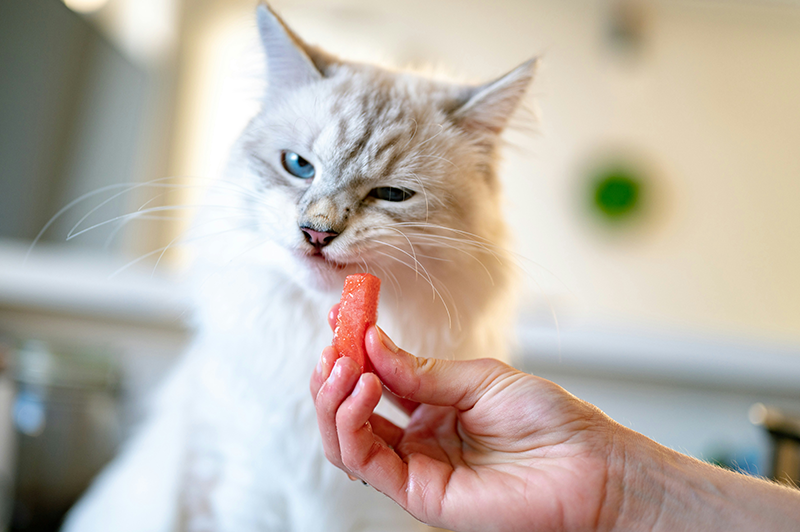
A Guide to Feeding Your Pet Safely
For National Food Safety Education Month in September, we’re shining a spotlight on feeding cats and dogs safely. We’ll cover common toxins, along with the “raw food” trend.
Raw Food Diet: It’s Not Worth the Risk
We’ve shared information about Raw Food Diet for Cats and Raw Food Diet for Dogs before, and our recommendation for both is the same: the risks outweigh any potential benefits. Both dogs and cats face these significant dangers:
- Nutritional deficiencies: With raw food, it’s nearly impossible to give your pet the balance of nutrients they need for good health. Commercially-manufactured pet food actually is formulated for pets’ dietary needs. There’s an important balance between fat and protein, along with nutrients like vitamin A, vitamin D, zinc, copper, taurine, calcium and carbohydrates.
- Foodborne illnesses: We cook raw meat for a reason. From slaughtering to butchering to storage in the grocery store fridge, there’s plenty of opportunity for raw meats to grow dangerous bacteria like Salmonella orListeria monocytogenes. These bacteria can cause serious illness or death in both animals and the people who feed them.
- Choking or punctures: Our modern cats and dogs just aren’t designed to chew and eat raw or cooked bones. Choking and punctured intestines are all too likely and often have tragic results.
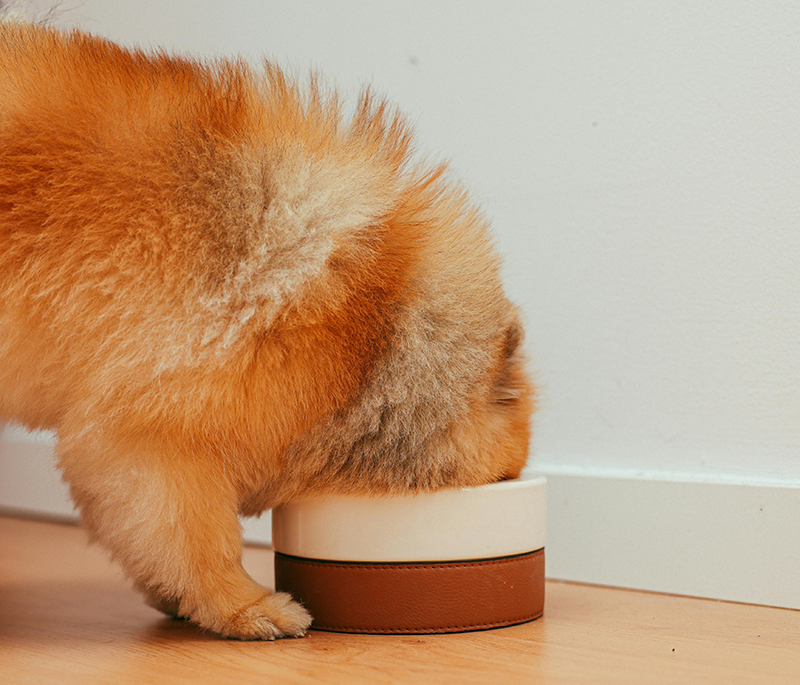
Foods that Are Dangerous to Pets
Our furry friends have different nutritional needs than humans, and many foods that are perfectly safe for us can be toxic or dangerous to dogs and cats. We all love to share human food with our pets, but we caution you to keep these ingredients away from your pets in both raw and cooked form.
- Alcohol
- Avocados
- Bones – cooked or raw
- Caffeine
- Candy or gum
- Chocolate
- Garlic
- Grapes
- Green tomatoes
- Marijuana
- Mustard – seeds, powder or the condiment
- Nutmeg
- Nuts
- Onions
- Raisins
- Raw potatoes
- Raw yeast dough
- Sage
- Xylitol – an artificial sweetener
We’d also like to point out that most cats become lactose-intolerant as they age.
We hope this information will help keep your pet safe from food dangers. Check out our Pet Poison Prevention Resources for more information on toxic plants, medications and more.
Read More
Top 30 Toxic Plants for Cats & Dogs
March 25, 2024

A Helpful Resource: Pet Poison Helpline’s US Plant Trends
We’ve covered Pet Poison Helpline’s Top 20 Pet Toxins in Ohio. Now, we’d like to highlight the organization’s Top Plants 2017-2022 and call out some of the most useful information from this tool.
The plant names link to Pet Poison Helpline’s plant information page. Percentages show the majority proportion of cases (cat or dog). We also give the organization’s toxicity level for each plant.
- Lilies of the Lilium species: 93.6% Cat, Severe toxicity
- Pothos/Devils ivy: 51.7% Cat, Moderate toxicity
- Sago/Cycad palm: 90.8% Dog, Severe toxicity
- Tulips: 56% Dog, Moderate toxicity
- Peace lily: 50% Cat, Moderate toxicity
- Azaleas: 78.5% Dog, Moderate-Severe toxicity
- Aloe: 54.4% Dog, Moderate toxicity
- Day lily: 87.9% Cat, Severe toxicity
- Hydrangea: 76.7% Dog, Mild toxicity
- Philodendron: 74.5% Dog, Moderate toxicity
- Alstroemeria, Peruvian lily: 96.2% Cat, Mild toxicity
- Jade plant: 69.9% Dog, Mild toxicity
- Daffodil: 66% Dog, Moderate toxicity
- Hosta: 92.1% Dog, Mild toxicity
- Monstera deliciosa: 58.8% Dog, Moderate toxicity
- Sansevieria, Snake plant, Mother-in-law’s tongue: 72.5% Dog, Moderate toxicity
- Ficus: 75.2% Dog, Mild toxicity
- Lantana: 96.1% Dog, Moderate toxicity
- Calla lily: 51.5% Cat, Moderate toxicity
- Kalanchoe: 55.4% Dog, Mild toxicity
- Dragon tree: 63.2% Cat, Moderate toxicity
- Rhododendron: 86.5% Dog, Moderate-Severe toxicity
- Elephant ear: 80.5% Dog, Moderate toxicity
- Dumbcane: 64.2% Dog, Moderate toxicity
- Corn plant/Ribbon plant: 53.3% Cat, Moderate toxicity
- Tomato: 73.1% Dog, Mild toxicity
- Chrysanthemum: 54.1% Dog, Mild toxicity
- Pokeweed: 98.7% Dog, Moderate toxicity
- Oleander: 91.8% Dog, Severe toxicity
- Poinsettia: 64.8% Dog, Mild toxicity
For Emergencies, Save the Pet Poison Helpline Number
Anytime of day or night, you can reach the Pet Poison Hotline at (855) 764-7661. As of this writing, the fee is $85.
Here are their recommended steps if you suspect your pet is experiencing an emergency after exposure to a pet toxin.

This spring, keep an eye out for poisons in plain sight— you may just save your cat or dog’s life.
Read More
2023’s Top 10 Pet Poisons
December 13, 2023

From Unexpected (Marijuana) to Perennial (Chocolate), Here are the Most Common Pet Toxins
The Pet Poison Helpline released its Top 10 Pet Poisons for 2023, and there are some notable entries for pet parents to be on the lookout for. Here’s the list, which takes into account all species of pet.
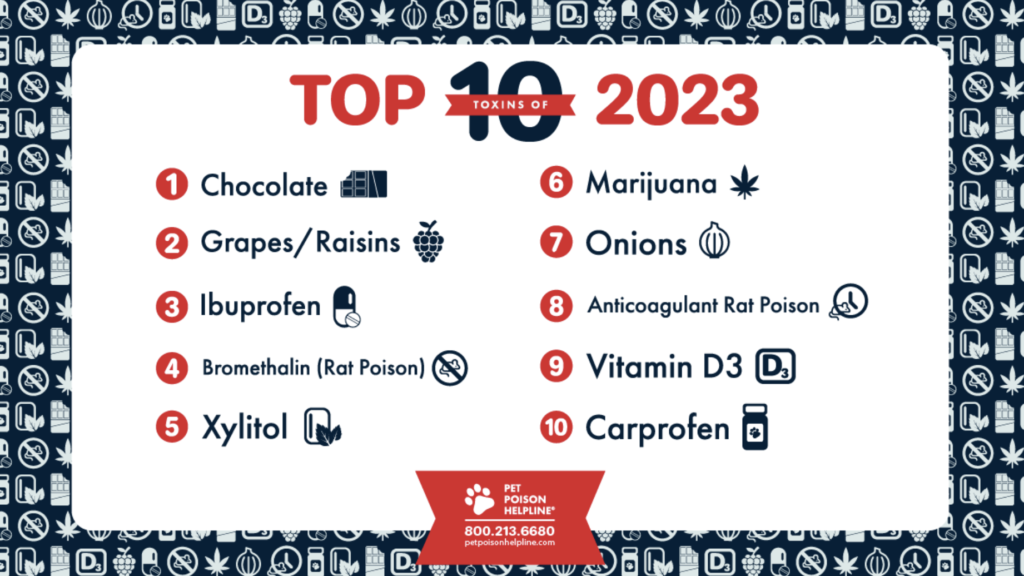
Marijuana Toxicity in Pets
New to the list this year is marijuana. The Pet Poison Helpline reports that it’s mostly dogs who encounter this toxicity. With the passage of Ohio’s Issue 2, we expect to see more cases in our state. On December 7, it became legal to possess marijuana and grow it at home.
The Pet Poison Helpline also provides stats on the pets it serves. Of all incident calls over the year:
- 88% dogs
- 11% cats
- 1% other species, like birds, small mammals, large animals and exotic species
Food Toxicities
It’s not surprising that chocolate tops the list, as it’s widely-available and undeniably tasty. Grapes and raisins are of special note, because their toxicity doesn’t seem to be as well-known as other foods. The same goes for onions.
Xylitol is an artificial sweetener used in many sugar-free candies, gums, desserts and recipes. We explored this pet toxin previously: Why is Xylitol Toxic for Dogs?
Medicine Toxicities
Human medicines aren’t meant for animals. Ibuprofen (Advil) is third on the list of most-common toxicities, and Vitamin D3 is a somewhat surprising addition. This list is a good reminder to keep all medicines out of reach of pets (and kids).
Veterinary medicines can also cause toxicity in the wrong dosage or if used for an extended period of time. Carprofen is a common NSAID used to treat pain and inflammation in animals, but overuse or overdose can cause toxicity. Fortunately, there are new treatments available to help with osteoarthritis pain, which we’ve written about:
Toxicities from Poisons
It’s truly sad when a pet ingests any rat poisons. Both bromethalin and anticoagulant rat poisons make the top 10 list. Rats are mammals, just like cats and dogs, so these poisons are indiscriminately toxic. We recommend using a different form of pest control.
Read More
Why is Xylitol Toxic for Dogs?
October 19, 2023
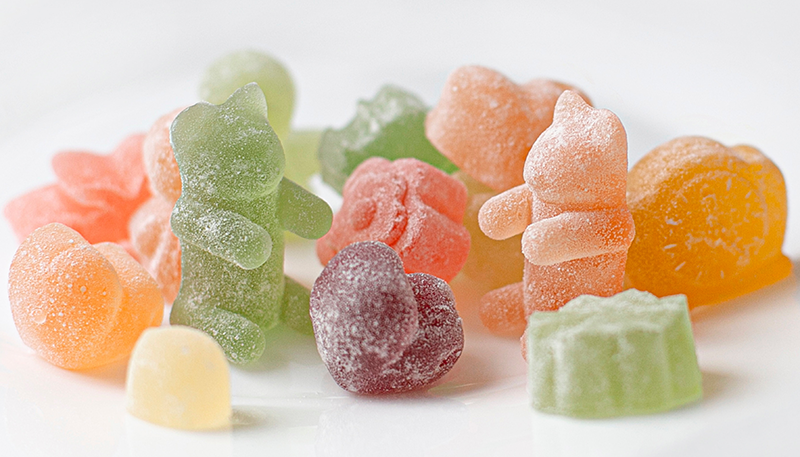
For Dogs, “Sugar-Free” Foods Can Be a Recipe for Danger
Xylitol is a sugar replacement ingredient to sweeten foods. It can be used in baking and is also found in sugar-free foods and products, like:
- Chewing gum
- Candy
- Baked goods
- Ice cream
- Peanut butter
- Jellies & jams
- Toothpaste
- Mouthwash
- Gummy vitamins & supplements
- Some liquid medicines
- Sunscreen (strangely enough!)
From a veterinary perspective, xylitol is a dangerous substance. It’s highly toxic for dogs, even in small doses. Depending on the size of your dog, even one stick of sugar-free gum could be deadly.
The FDA created this helpful poster with good information, check it out below:
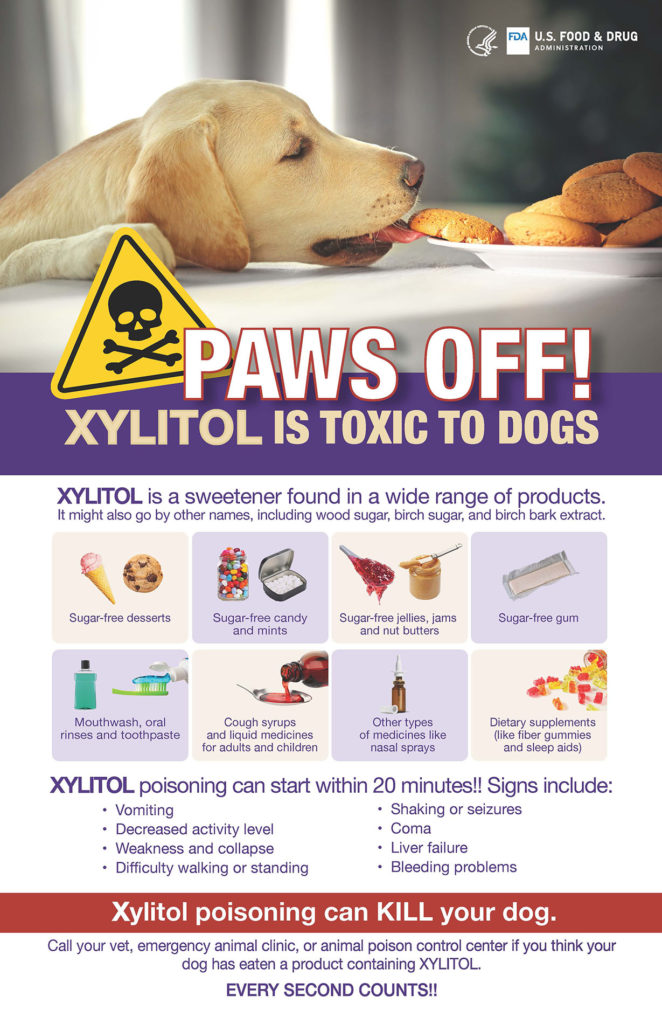
How Xylitol Harms Dogs
Xylitol toxicity works by lowering a dog’s blood sugar to dangerous levels. It triggers a large release of insulin, which makes blood sugar drop.
In some dogs, the substance can also cause irreversible and fatal liver failure.
Signs of Xylitol Toxicity in Dogs
Xylitol toxicity happens quickly, within a few hours of ingestion. Symptoms are common to other ailments, and include:
- Lethargy
- Weakness
- Trouble walking
- Tremors/shakes
- Vomiting/diarrhea
- Seizure
- Coma
- Death
The important takeaway is that minutes matter. If you know your dog ingested xylitol, get veterinary help right away.
Treatment is Possible
In the early stages, treatment for xylitol toxicity is possible. It:
“usually requires a short hospitalization stay with intravenous dextrose supplementation and other supportive medications… For most cases, with proper recognition and treatment, it is favorable as long as the dog has not ingested enough to cause liver damage.”

Xylitol, Also Known As…
Recently, food brands have started listing xylitol under different names, such as:
- Wood sugar
- Birch sugar
- Birch bark extract
Be especially careful to check the ingredient list of any sugar-free foods to know which contain any of those ingredient names. Keep these foods well away from your dog.
Ruby’s Sad Story
Sadly, dogs die every year from xylitol toxicity. And not everyone knows the danger of this “sugar-free” replacement. Here’s one cautionary tale:
“Ruby stole two of my homemade brownies. Nothing new – she’s stolen them before from sealed boxes, with no adverse affects – but this time I’d cooked with Xylitol. I had no idea that she should be rushed immediately to the vet to begin intensive, invasive treatment which might – just might – have saved her.”
What About Cats & Xylitol?
There’s no evidence at present that xylitol is toxic to cats. However, this doesn’t mean sugar-free foods sweetened with xylitol are safe for cats, either. We recommend keeping xylitol-containing foods away from your cat and to offer known safe cat treats, instead.
Concerned that your pet may have encountered xylitol? Every minute counts. Call us during our regular hours, or reach out to an emergency vet after hours.
Read More
Pet Poisons in Plain Sight
March 14, 2023
Top 10 Toxins and Poisons for Cats and Dogs
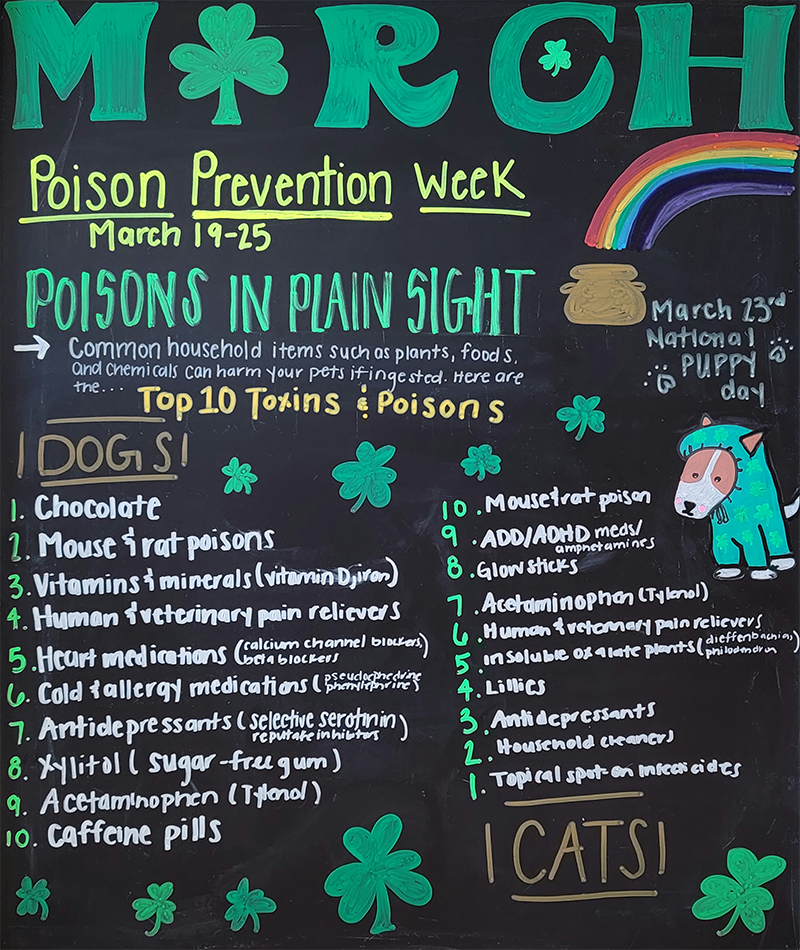
Common household items such as plants, foods and chemicals can harm your pets if ingested. We’re highlighting these in observance of Poison Prevention Week.
Cats and dogs share many sensitivities, but the top toxins for each have some notable exceptions. It’s best to keep all substances like cleaning supplies and medications completely out of reach for your pet.

Top 10 Toxins and Poisons for Dogs
Some of these toxins are fairly well-known, but several might surprise you. These toxicities are commonly seen by veterinarians. Keep all of them away from your dog’s reach.
- Chocolate
- Mouse and rat poisons
- Vitamins and minerals, specifically Vitamin D and Iron supplements
- Human and veterinary pain relievers
- Heart medications, especially calcium channel blockers and beta blockers
- Cold and allergy medications like pseudoephedrine and phenylephrine
- Antidepressants such as selective serotonin reuptake inhibitors (SSRI)
- Xylitol, an artificial sweetener often found in sugar-free gum
- Acetaminophen (Tylenol)
- Caffeine pills

Top 10 Toxins and Poisons for Cats
Cats have several specific toxins that can be fatal. It’s very important to keep these 10 items away from your cat:
- Topical, spot-on insecticides. These flea and tick insecticides are typically safe for dogs but never for cats. They include drugs from the pyrethrin and pyrethroid family
- Household cleaners
- Antidepressants such as selective serotonin reuptake inhibitors (SSRI)
- Lilies of every variety
- Insoluble oxalate plants, such as Dieffenbachia, philodendron, umbrella plant, elephant’s ear
- Human and veterinary pain relievers
- Acetaminophen (Tylenol)
- Glowsticks
- ADD/ADHD medications, i.e., amphetamines
- Mouse and rat poisons
Animal Poison Control Options
If your pet has ingested a suspected toxin, and you can’t get in touch with your veterinarian, these animal poison control lines are good resources:
For more information, check our our articles “Indoor Hazards for Pets” and “Outdoor Hazards for Pets.”
Read More
Pet Poison Prevention Awareness Month
March 16, 2022

March into Spring with Knowledge to Protect Your Pet from Toxins
The month of March is Pet Poison Prevention Awareness Month. We’ve written before about Indoor Hazards for Pets and Outdoor Hazards for Pets, along with the Signs of Toxicity. This time, the focus is on common toxins found during the spring.
Most Common Pet Toxins in the Spring
With longer, warmer days, you and your pet may both be spending more time outside. In the spring, pay special attention to those outdoor toxins, along with plants you may bring inside, such as:

Toxic Plants
- Tulips and hyacinths
- Daffodils
- Lilies
- Crocuses
- Lily of the valley
Toxic Gardening Ingredients
Just because your fertilizer is organic, doesn’t mean it’s safe for your pets. Blood meal and bone meal are both popular organic fertilizer ingredients. Dried blood and bone will be naturally appealing to cats and dogs, but can cause vomiting, iron toxicity or intestinal blockages.
Some fertilizers are fortified with iron, which can cause iron toxicity if your pet ingests it. Also watch for disulfoton in rose and plant fertilizer, which is highly toxic.
And the Pet Poison Helpline has this advice about pesticides and insecticides:
“Most pesticides or insecticides (typically those that come in a spray can) are basic irritants to the pet and are usually not a huge concern unless a pet’s symptoms become persistent. Some may contain an organophosphate which can be life threatening when consumed in large quantities. It is always best to speak to a trained medical professional if there are any questions.”

Toxicities to Watch for Around Easter and Passover
Family celebrations are wonderful, but also a time when it’s easy for your pet to get into something they shouldn’t. Around Easter and Passover, watch out for:
- Chocolate
- Fake “Easter grass”
- Candy with Xylitol in it
- Raw or cooked animal bones
- Raw or cooked animal fat
- Cooking ingredients like onions, garlic, chives, leeks
- Alcohol
Animal Poison Control Options
If your pet has ingested a suspected toxin, and you can’t get in touch with your veterinarian, these animal poison control lines are good resources:
Just this month, ASPCA Animal Poison Control announced its four millionth case in its 45-year history. You may be interested to know:
“Established in 1978, the APCC is the only facility of its kind and is staffed by 70 veterinarians, including 11 board-certified veterinary toxicologists, 100 certified veterinary technicians and 13 veterinary assistants. The APCC has developed a sophisticated veterinary database system called AnTox™ that helps identify and characterize toxic effects of substances in animals and enables the ASPCA to collect more patient data than any other veterinary toxicology medical record system in the world.”
Have questions about how to create a toxin-free, safe environment for your pet? Contact us.
Read More



















